How to Find Big-Water Smallmouth in Fall
A Sturgeon Bay guide shares his best strategies for finding late-season fish

Dale Stroschein is one of the lucky ones. He grew up on Sturgeon Bay and has spent nearly 35 years guiding full time for smallmouth bass and walleyes on the famed fishery.
In Stroschein’s case, staying on the smallmouth bite throughout the fall just means working every day. For out-of-towners or anyone not so fortunate to work on the water, Stroschein has some practical advice for locating big-water smallmouth bass this time of year.
His approach obviously works well in the Sturgeon Bay area, which includes Green Bay and Lake Michigan, but most of what he suggests works in other smallie-rich corners of the Great Lakes, too.

Know where the bass are going
The key to finding smallmouth bass on big water in the fall is to know where they’re coming from and where they’re heading, then connecting the dots in between.
Stroschein says a lot of the smallies in the Sturgeon Bay area move to offshore structure and main-lake shorelines in the summertime, while the rest are resident fish that linger around the spawning bays. In winter, they pile into the deepest parts of the fishery – as deep as 80 to 100 feet in some cases.
In between those seasons, Stroschein targets fall smallies in places that are similar to summer spots, but within close proximity to wintering areas.
“Primarily what I’m looking for is deep water that’s close to structure,” Stroschein says. “They want to be close to structure, but they also want to be close to that deep water, especially in fall because they’ll inevitably move out and get to a point where they’re going to winter.”
Stroschein searches for edges of shoals, reefs/rock piles, and main-lake shorelines with steep drop-offs that are adjacent to 30 to 50 feet of water. The tops of those target areas can range from a few feet deep to 25 feet or deeper, but they all fall quickly to deeper water.

“Those are going to be the most heavily used traffic areas that these fish are going to relate to, in comparison to a big, long flat that takes maybe hundreds of yards to get to any kind of deep water.”
Bass will “yard up,” or school together best on these structures once the water temperature creeps into the low 60s. Once it drops below 50 degrees, Stroschein says it’s truly game on.
A final note about location is to not overlook some shallow zones, especially early in the fall. According to Stroschein, a lot of the crayfish that smallmouths love to eat live in rocky areas less than about 4 feet deep because that’s roughly the shallow edge of where zebra mussels are found in his region. He’s caught craw-eating smallies in surprisingly shallow water throughout much of the open-water season.

Search quickly to cover big water
Stroschein’s approach to finding schools of smallmouth bass is two-fold, using electronics first and then quickly fan-casting the best-looking structure. Rarely does he park in one spot and try to pinpoint-fish a specific waypoint from a previous trip. The fishery is too dynamic to fish memories anyway. He’ll use his eyes and his lure to locate fish, then work over the school as long as he can. Then he rolls to the next spot.
“Here we’ve got so much water, and day in and day out we’ve got different currents and different winds, and it’s constantly moving that bait,” he says. “You have a lot of fishy locations, but they’re changing up from hour to hour, or two days to two days, or week to week. So I’m constantly pulling into a spot and covering it quickly. If they’re there, they’re going to bite you. When you have confidence in a number of different tactics, you can dissect an area of a lake or a spot relatively quickly.”
Stroschein suggests spending more time idling and graphing the largest areas – an island complex, an extended shoreline drop-off, a vast shoal – to see where fish are holding. These areas could stretch for a mile or so.
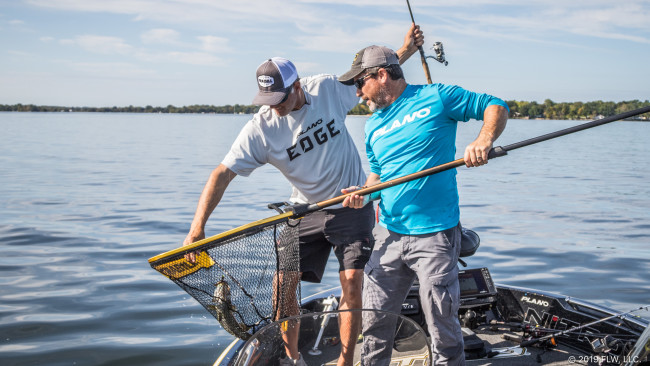
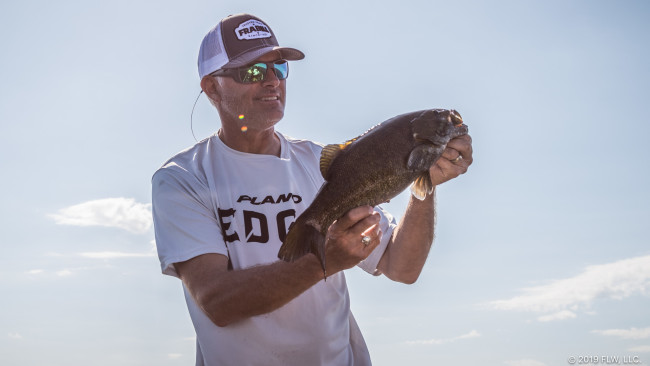
“You might have a little bit more sandy, rock transitions or some bigger rocks, and you’ve got to learn those areas on those ‘broader horizons,’ if you will, than if you get on some of those smaller structural locations,” Stroschein explains. “You can get on those smaller spots, and a guy can comfortably fish those pretty quickly and learn it very easily.”
On a large shoal, as an example, Stroschein might pull up in an area where he marked fish, set his MotorGuide to hold his boat in place, and fan-cast in every direction around the boat. Once he’s exhausted options there, he moves to a new part of the shoal and repeats the process.
It’s a bit of a variation from classic Southern offshore fishing, where the angler usually holds off the edge and fires up onto the drop, but it works well for picking apart the kinds of big structure that are found in parts of the Great Lakes.
On smaller targets, a more traditional approach of positioning downwind and firing onto the structure is the better bet.
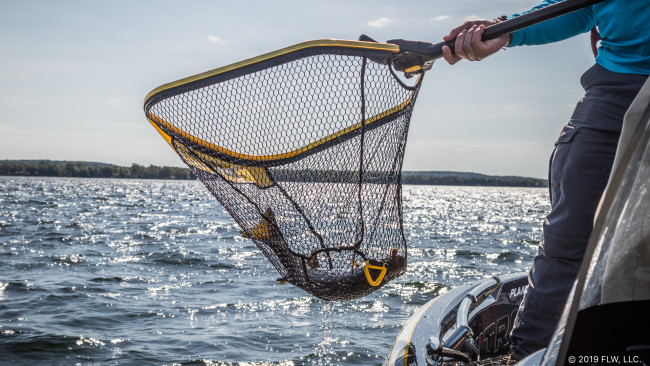
Play the wind for fall fishing success
Wind is a major factor in smallmouth fishing success on big water. According to Stroschein, in the fall you always want to fish windblown structure. Wind pushes bait into these areas, and the surface chop camouflages an angler’s approach.
However, too much wind is a real issue in the fall, and you should always be aware of the potential for dangerous conditions. In Door County, anglers can usually escape the worst of it by fishing a bay with a little protection or hitting the leeward side of the Door Peninsula to find safe waters. That may or may not be the case in other regions.
Wind also influences his target depth.
“If it’s calm, everything’s a go,” says Stroschein. “You can work shallow or deeper. If you’ve got a rough day, really focus on that 6 to, maybe, 15 feet of water.”
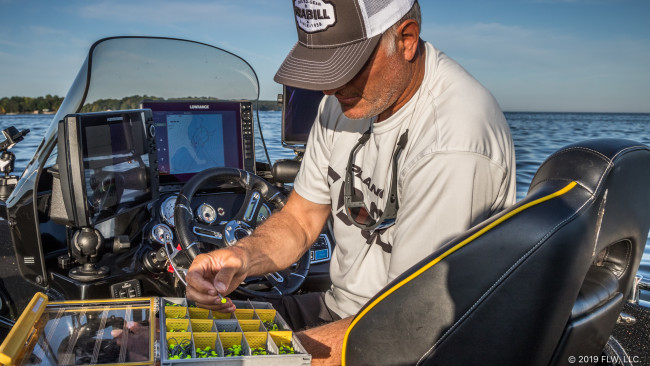
Go-to smallmouth patterns
You can catch smallmouths a lot of ways in the fall, but here’s Stroschein’s best rule to fish by: On calm days, finesse fish with plastics. On rougher days, cast and retrieve power-fishing baits.
On the finesse side, drop-shots and wacky rigs work well, but Stroschein is lethal with a Ned rig. His preferred setup is a chartreuse Berkley Half Head Jig with about a 3-inch soft-plastic stick bait. Rather than drag the rig, he works it by letting it hit bottom, then giving it one quick turn of the reel handle. The bait will hop forward and fall back. As it gets closer to the boat, the retrieve angle increases, and Stroschein gets a lot of reaction bites on the drop.
This method also helps reduce snags on zebra mussels because the bait hops along, rather than dragging into obstructions.
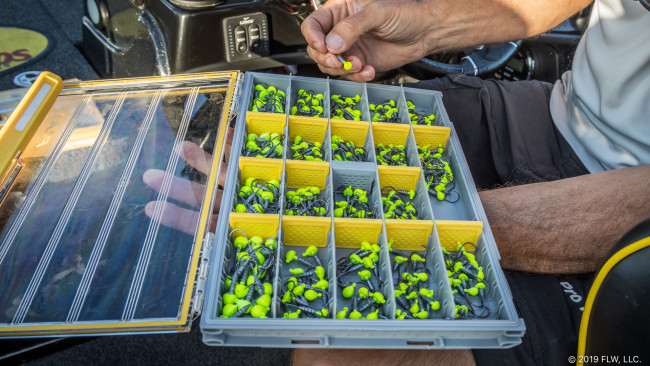

Stroschein power fishes with a number of tactics but really leans hard on baits he can bomb a long distance in the clear water.
Slow-rolling a lipless bait such as a Rapala Clackin’ Rap on the break is one of his favorites. For triggering reaction bites, he’ll hop a blade bait off bottom, or do the same with a minnow-type jigging bait such as a Moonshine Lures Shiver Minnow or a Johnson Johnny Darter.
Another productive way to catch smallmouths is to pair a 3/8-ounce Bait Rigs Slo-Poke LS Long Shank Jig with a small swimbait.
“I’ll be in 25 to 30 feet, throw it out, and then give it a 15 or 16 count and slow-roll it with a 5:1 reel,” Stroschein says of the swimbait.
Other options that work are ChatterBaits, double-willow spinnerbaits up to about 1 1/4 ounce and crankbaits.
Trolling: another way to cover water
The Great Lakes region is big-water trolling country, and even the bass can’t fully escape a trolling presentation.
According to Stroschein, on windy days, a lot of locals will long-line or drift-troll their favorite bass jerkbaits along deep breaks on windblown shorelines. Granted, many of them are fishing in V-hull multi-species boats that have room in the rear to troll comfortably.
“I mean, they will absolutely crush them,” Stroschein adds. “They set up on a drift, throw it out, give it a lot of line [100 feet or so], then just sit back and hang on to the rod or put the rod in a holder. The boat’s doing all the work. It’ll speed up on the wave and then stall in the swell and then speed up on the wave. You surge and stall and surge and stall, so it’s creating all the action in the lure all on its own. I know many guys that do that a lot because there’s really nothing else they can do efficiently in the wind.”
Trolling may or may not be on your list of acceptable ways to catch a bass, and that’s fine. With Stroschein’s tips and some smallmouth common sense, you can use just about any type of approach you want to stick some fat bronze bass on big water during one of the best times of year to be in the North Country.